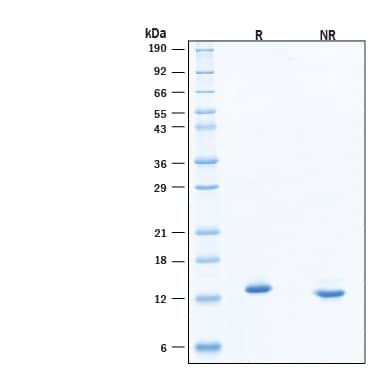Recombinant Human NT-3 Protein, CF
R&D Systems, part of Bio-Techne | Catalog # 11563-N3

Key Product Details
Product Specifications
Source
Tyr139-Thr257
Purity
Endotoxin Level
N-terminal Sequence Analysis
Predicted Molecular Mass
SDS-PAGE
Activity
The ED50 for this effect is 5.00-70.0 ng/mL.
Scientific Data Images for Recombinant Human NT-3 Protein, CF
Recombinant Human NT‑3 Protein Bioactivity.
Recombinant Human NT‑3 Protein (Catalog # 11563-N3) stimulates cell proliferation in the BaF mouse pro-B cell line transfected with TrkB. The ED50 for this effect is 5.00-70.0 ng/mL.Recombinant Human NT‑3 Protein SDS-PAGE.
2 μg/lane of Recombinant Human NT‑3 Protein (Catalog # 11563-N3) was resolved with SDS-PAGE under reducing (R) and non-reducing (NR) conditions and visualized by Coomassie® Blue staining, showing bands at 12-15 kDa, under reducing conditions.Formulation, Preparation and Storage
11563-N3
| Formulation | Lyophilized from a 0.2 μm filtered solution in PBS with Trehalose. |
| Reconstitution | Reconstitute the 10 μg size at 100 μg/mL in PBS. Reconstitute all other sizes at 250 μg/mL in PBS. |
| Shipping | The product is shipped at ambient temperature. Upon receipt, store it immediately at the temperature recommended below. |
| Stability & Storage | Use a manual defrost freezer and avoid repeated freeze-thaw cycles.
|
Background: NT-3
Neurotrophin-3 (NT-3) is a member of the NGF family of neurotrophic factors (also named neurotrophins) that are required for the differentiation and survival of specific neuronal subpopulations in both the central as well as the peripheral nervous systems. The neurotrophin family is comprised of at least four proteins including NGF, BDNF, NT-3, and NT-4/5. These secreted cytokines are synthesized as prepropeptides that are proteolytically processed to generate the mature proteins. All neurotrophins have six conserved cysteine residues that are involved in the formation of three disulfide bonds and all share approximately 55% sequence identity at the amino acid level. Similarly to NGF, bioactive NT-3 is predicted to be a non-covalently linked homodimer.
The NT-3 cDNA encodes a 257 amino acid residue precursor protein with a signal peptide and a proprotein that are cleaved to yield the 119 amino acid residue mature NT-3. The amino acid sequence of mature NT-3 is identical in human, mouse and rat. NT-3 transcripts have been detected in the cerebellum, hippocampus, placenta, heart, skin, and skeletal muscle. NT-3 primarily activates the TrkC tyrosine kinase receptor. In addition, NT-3 can activate Trk and TrkB kinase receptors in certain cell systems. NT-3 can also bind with low affinity to the low affinity NGF receptor.
References
- Eide, F.F. et al. (1993) Exp. Neurol. 121:200.
- Snider, W.D. (1994) Cell 77:627.
- Barbacid, M. (1994) J. Neurobiol. 25:1386.
Long Name
Alternate Names
Entrez Gene IDs
Gene Symbol
UniProt
Additional NT-3 Products
Product Documents for Recombinant Human NT-3 Protein, CF
Product Specific Notices for Recombinant Human NT-3 Protein, CF
For research use only

